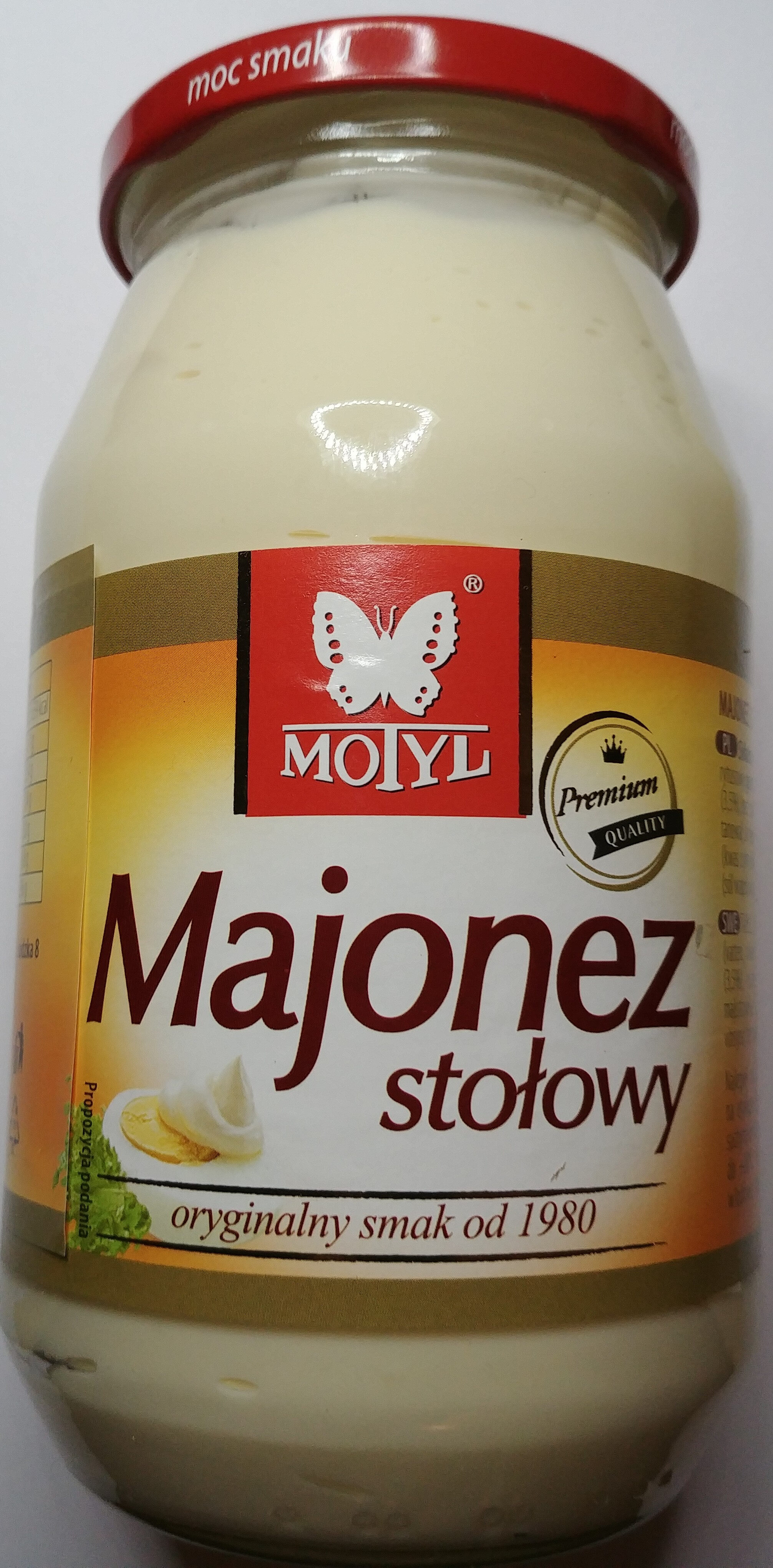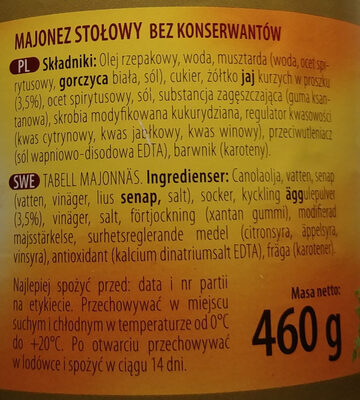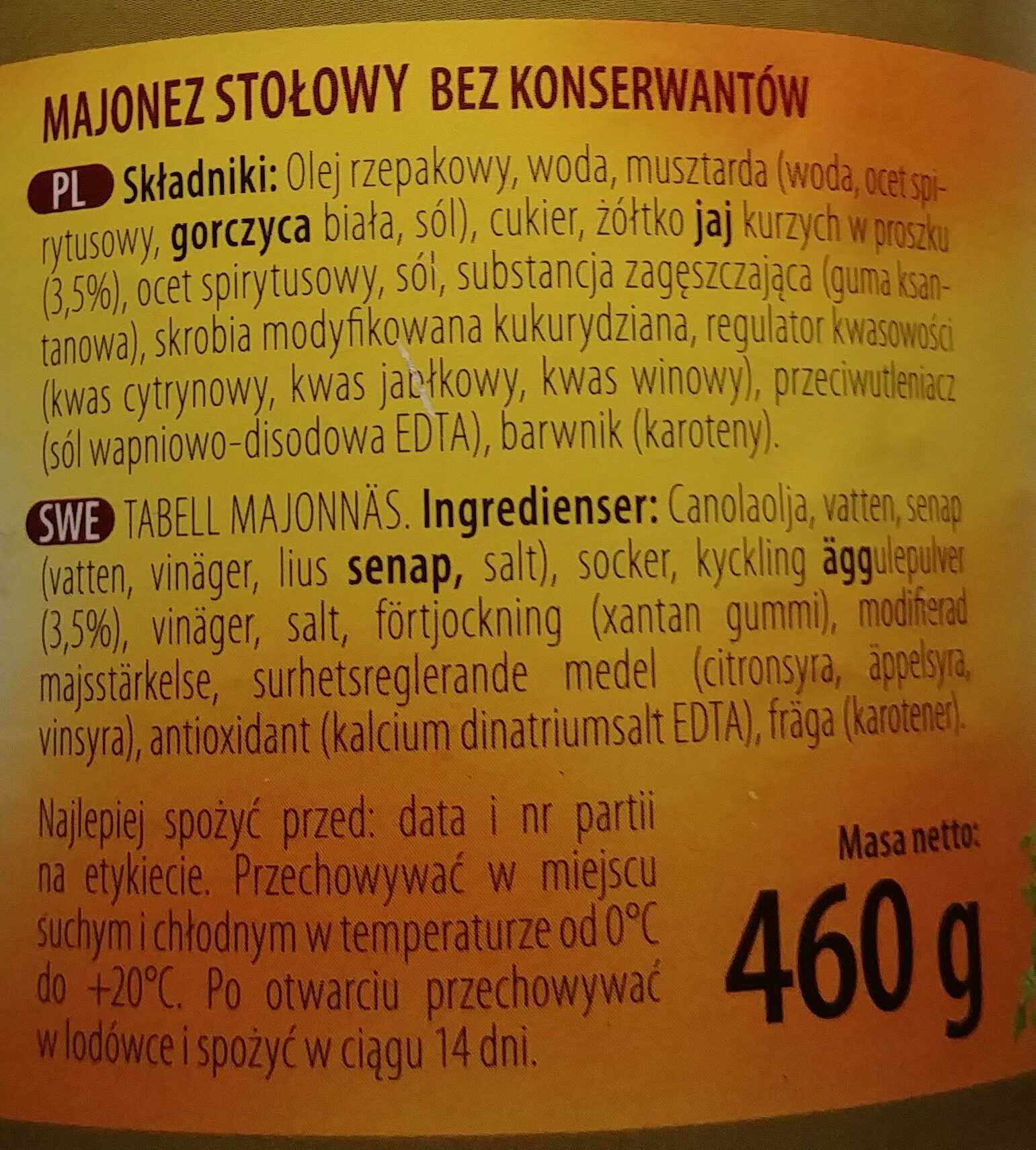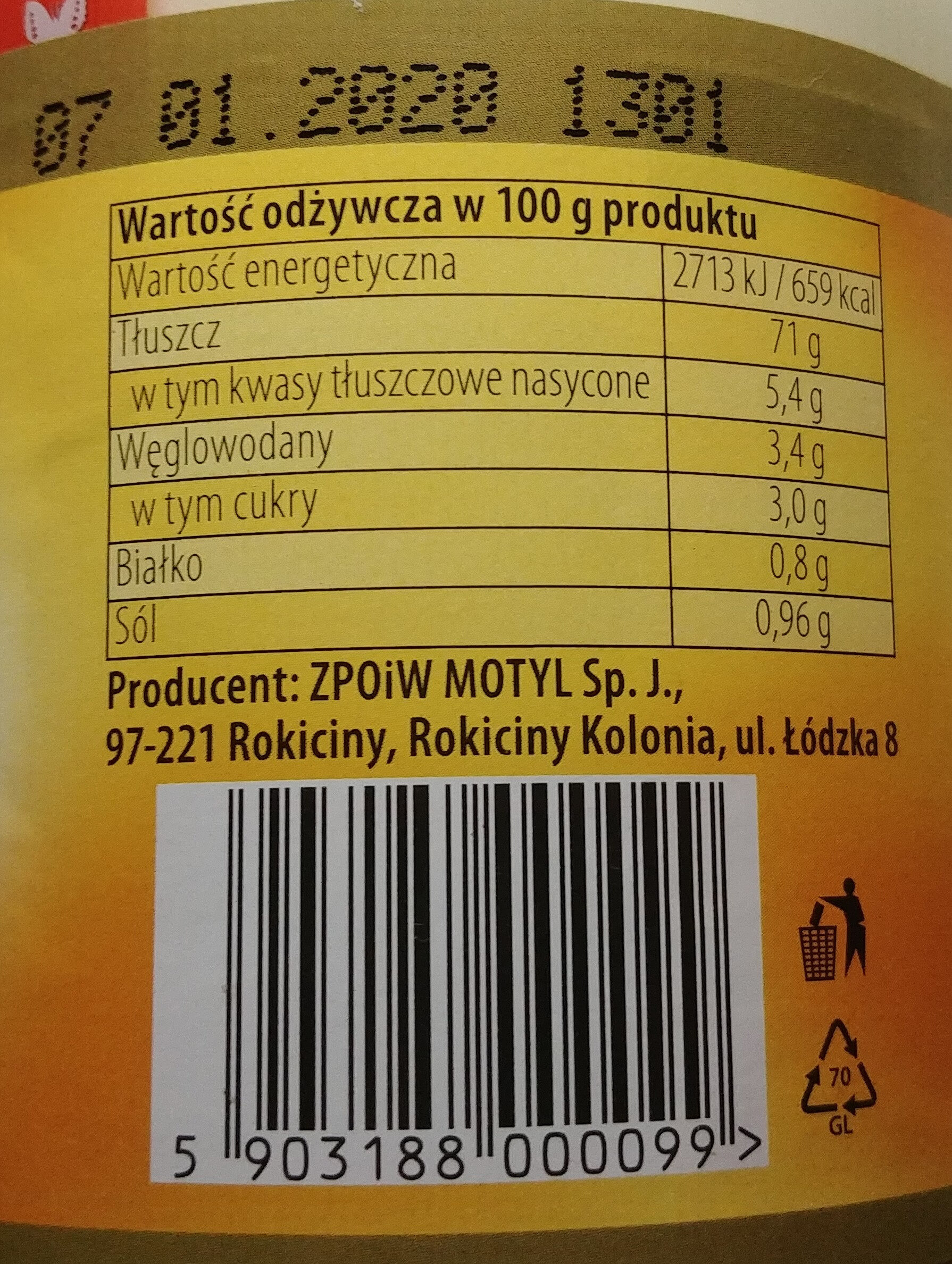Help us make food transparency the norm!
As a non-profit organization, we depend on your donations to continue informing consumers around the world about what they eat.
The food revolution starts with you!
Majonez stołowy - Motyl - 460 g
Majonez stołowy - Motyl - 460 g
This product page is not complete. You can help to complete it by editing it and adding more data from the photos we have, or by taking more photos using the app for Android or iPhone/iPad. Thank you!
×
Streckkod: 5903188000099 (EAN / EAN-13)
Kvantitet: 460 g
Förpackning: Glas, Klart glas
Varumärken: Motyl
Kategorier: en:Condiments, Såser, Majonnäser
Ingredients ursprung: Polen
Tillverknings eller bearbetningsplats: PL 97-221, Rokiciny, Polska
Butiker: Dino
Matching with your preferences
Hälsa
Ingredienser
-
22 ingredienser
Polska: Olej rzepakowy, woda, musztarda (woda, ocet spirytusowy, gorczyca biała, sól), cukier, żółtko jaj kurzych w proszku (3,5%), ocet spirytusowy, sól, substancja zagęszczająca (guma ksantanowa), skrobia modyfikowana kukurydziana, regulator kwasowości (kwas cytrynowy, kwas jabłkowy, kwas winowy), przeciwutleniacz (sól wapniowo-disodowa EDTA), barwnik (karoteny).Allergener: Ägg, Senap
Food processing
-
Ultra processed foods
Elements that indicate the product is in the 4 - Ultra bearbetade livsmedel och drycker group:
- Tillsats: E160a - Karoten
- Tillsats: E415 - Xantangummi
- Ingrediens: Färg
- Ingrediens: Förtjockningsmedel
Food products are classified into 4 groups according to their degree of processing:
- Obearbetade eller minimalt bearbetade livsmedel
- Bearbetade kulinariska ingredienser
- Halvfabrikat
- Ultra processed foods
The determination of the group is based on the category of the product and on the ingredients it contains.
Tillsatser
-
E160a - Karoten
Carotene: The term carotene -also carotin, from the Latin carota, "carrot"- is used for many related unsaturated hydrocarbon substances having the formula C40Hx, which are synthesized by plants but in general cannot be made by animals -with the exception of some aphids and spider mites which acquired the synthesizing genes from fungi-. Carotenes are photosynthetic pigments important for photosynthesis. Carotenes contain no oxygen atoms. They absorb ultraviolet, violet, and blue light and scatter orange or red light, and -in low concentrations- yellow light. Carotenes are responsible for the orange colour of the carrot, for which this class of chemicals is named, and for the colours of many other fruits, vegetables and fungi -for example, sweet potatoes, chanterelle and orange cantaloupe melon-. Carotenes are also responsible for the orange -but not all of the yellow- colours in dry foliage. They also -in lower concentrations- impart the yellow coloration to milk-fat and butter. Omnivorous animal species which are relatively poor converters of coloured dietary carotenoids to colourless retinoids have yellowed-coloured body fat, as a result of the carotenoid retention from the vegetable portion of their diet. The typical yellow-coloured fat of humans and chickens is a result of fat storage of carotenes from their diets. Carotenes contribute to photosynthesis by transmitting the light energy they absorb to chlorophyll. They also protect plant tissues by helping to absorb the energy from singlet oxygen, an excited form of the oxygen molecule O2 which is formed during photosynthesis. β-Carotene is composed of two retinyl groups, and is broken down in the mucosa of the human small intestine by β-carotene 15‚15'-monooxygenase to retinal, a form of vitamin A. β-Carotene can be stored in the liver and body fat and converted to retinal as needed, thus making it a form of vitamin A for humans and some other mammals. The carotenes α-carotene and γ-carotene, due to their single retinyl group -β-ionone ring-, also have some vitamin A activity -though less than β-carotene-, as does the xanthophyll carotenoid β-cryptoxanthin. All other carotenoids, including lycopene, have no beta-ring and thus no vitamin A activity -although they may have antioxidant activity and thus biological activity in other ways-. Animal species differ greatly in their ability to convert retinyl -beta-ionone- containing carotenoids to retinals. Carnivores in general are poor converters of dietary ionone-containing carotenoids. Pure carnivores such as ferrets lack β-carotene 15‚15'-monooxygenase and cannot convert any carotenoids to retinals at all -resulting in carotenes not being a form of vitamin A for this species-; while cats can convert a trace of β-carotene to retinol, although the amount is totally insufficient for meeting their daily retinol needs.Källa: Wikipedia (Engelska)
-
E296 - Äppelsyra
Malic acid: Malic acid is an organic compound with the molecular formula C4H6O5. It is a dicarboxylic acid that is made by all living organisms, contributes to the pleasantly sour taste of fruits, and is used as a food additive. Malic acid has two stereoisomeric forms -L- and D-enantiomers-, though only the L-isomer exists naturally. The salts and esters of malic acid are known as malates. The malate anion is an intermediate in the citric acid cycle.Källa: Wikipedia (Engelska)
-
E330 - Citronsyra
Citric acid: Citric acid is a weak organic acid that has the chemical formula C6H8O7. It occurs naturally in citrus fruits. In biochemistry, it is an intermediate in the citric acid cycle, which occurs in the metabolism of all aerobic organisms. More than a million tons of citric acid are manufactured every year. It is used widely as an acidifier, as a flavoring and chelating agent.A citrate is a derivative of citric acid; that is, the salts, esters, and the polyatomic anion found in solution. An example of the former, a salt is trisodium citrate; an ester is triethyl citrate. When part of a salt, the formula of the citrate ion is written as C6H5O3−7 or C3H5O-COO-3−3.Källa: Wikipedia (Engelska)
-
E334 - L(+)-vinsyra
Tartaric acid: Tartaric acid is a white, crystalline organic acid that occurs naturally in many fruits, most notably in grapes, but also in bananas, tamarinds, and citrus. Its salt, potassium bitartrate, commonly known as cream of tartar, develops naturally in the process of winemaking. It is commonly mixed with sodium bicarbonate and is sold as baking powder used as a leavening agent in food preparation. The acid itself is added to foods as an antioxidant and to impart its distinctive sour taste. Tartaric is an alpha-hydroxy-carboxylic acid, is diprotic and aldaric in acid characteristics, and is a dihydroxyl derivative of succinic acid.Källa: Wikipedia (Engelska)
-
E415 - Xantangummi
Xanthan gum: Xanthan gum -- is a polysaccharide with many industrial uses, including as a common food additive. It is an effective thickening agent and stabilizer to prevent ingredients from separating. It can be produced from simple sugars using a fermentation process, and derives its name from the species of bacteria used, Xanthomonas campestris.Källa: Wikipedia (Engelska)
Ingrediensanalys
-
Kan innehålla palmolja
Ingredienser som kan innehålla palmolja: E160a
-
Icke-vegan
Non-vegan ingredients: en:Chicken egg yolk powder
-
Vegetarisk status okänd
Okända ingredienser: Senap
-
Details of the analysis of the ingredients
pl: Olej rzepakowy, woda, musztarda (woda, ocet spirytusowy, _gorczyca_ biała, sól), cukier, żółtko _jaj_ kurzych w proszku 3.5%, ocet spirytusowy, sól, substancja zagęszczająca (guma ksantanowa), skrobia modyfikowana kukurydziana, regulator kwasowości (kwas cytrynowy, kwas jabłkowy, kwas winowy), przeciwutleniacz (sól wapniowo-disodowa EDTA), barwnik (karoteny)- Olej rzepakowy -> en:rapeseed-oil - vegan: yes - vegetarian: yes - from_palm_oil: no - percent_min: 9.49000000000001 - percent_max: 86
- woda -> en:water - vegan: yes - vegetarian: yes - ciqual_food_code: 18066 - percent_min: 3.5 - percent_max: 44.75
- musztarda -> en:mustard - ciqual_food_code: 11013 - percent_min: 3.5 - percent_max: 31
- woda -> en:water - vegan: yes - vegetarian: yes - ciqual_food_code: 18066 - percent_min: 0.875 - percent_max: 31
- ocet spirytusowy -> en:spirit-vinegar - vegan: yes - vegetarian: yes - ciqual_food_code: 11018 - percent_min: 0 - percent_max: 15.5
- _gorczyca_ biała -> en:yellow-mustard-seed - vegan: yes - vegetarian: yes - ciqual_food_code: 11013 - percent_min: 0 - percent_max: 10.3333333333333
- sól -> en:salt - vegan: yes - vegetarian: yes - ciqual_food_code: 11058 - percent_min: 0 - percent_max: 0.96
- cukier -> en:sugar - vegan: yes - vegetarian: yes - ciqual_proxy_food_code: 31016 - percent_min: 3.5 - percent_max: 3
- żółtko _jaj_ kurzych w proszku -> en:chicken-egg-yolk-powder - vegan: no - vegetarian: yes - ciqual_food_code: 22002 - percent_min: 3.5 - percent: 3.5 - percent_max: 3
- ocet spirytusowy -> en:spirit-vinegar - vegan: yes - vegetarian: yes - ciqual_food_code: 11018 - percent_min: 0 - percent_max: 3
- sól -> en:salt - vegan: yes - vegetarian: yes - ciqual_food_code: 11058 - percent_min: 0 - percent_max: 0.96
- substancja zagęszczająca -> en:thickener - percent_min: 0 - percent_max: 0.96
- guma ksantanowa -> en:e415 - vegan: yes - vegetarian: yes - percent_min: 0 - percent_max: 0.96
- skrobia modyfikowana kukurydziana -> en:modified-corn-starch - vegan: yes - vegetarian: yes - ciqual_food_code: 9510 - percent_min: 0 - percent_max: 0.96
- regulator kwasowości -> en:acidity-regulator - percent_min: 0 - percent_max: 0.96
- kwas cytrynowy -> en:e330 - vegan: yes - vegetarian: yes - percent_min: 0 - percent_max: 0.96
- kwas jabłkowy -> en:e296 - vegan: yes - vegetarian: yes - percent_min: 0 - percent_max: 0.48
- kwas winowy -> en:e334 - vegan: yes - vegetarian: yes - percent_min: 0 - percent_max: 0.32
- przeciwutleniacz -> en:antioxidant - percent_min: 0 - percent_max: 0.96
- sól wapniowo-disodowa EDTA -> en:e385 - vegan: yes - vegetarian: yes - percent_min: 0 - percent_max: 0.96
- barwnik -> en:colour - percent_min: 0 - percent_max: 0.96
- karoteny -> en:e160a - vegan: maybe - vegetarian: maybe - from_palm_oil: maybe - percent_min: 0 - percent_max: 0.96
Näring
-
Poor nutritional quality
⚠ ️Varning: mängden fibrer är inte angiven, eventuella positiv inverkan på betyget kunde inte beaktas.⚠ ️Warning: the amount of fruits, vegetables and nuts is not specified on the label, it was estimated from the list of ingredients: 47This product is not considered a beverage for the calculation of the Nutri-Score.
Positiva poäng: 1
- Proteiner: 0 / 5 (värde: 0.8, avrundat värde: 0.8)
- Fiber: 0 / 5 (värde: 0, avrundat värde: 0)
- Frukt, grönsaker, nötter och raps- / valnöt- / olivoljor: 1 / 5 (värde: 47.745, avrundat värde: 47.7)
Negativa poäng: 17
- Energi: 8 / 10 (värde: 2757, avrundat värde: 2757)
- Socker: 0 / 10 (värde: 3, avrundat värde: 3)
- Mättat fett: 5 / 10 (värde: 5.4, avrundat värde: 5.4)
- Natrium: 4 / 10 (värde: 384, avrundat värde: 384)
The points for proteins are not counted because the negative points are greater or equal to 11.
Näringsvärde: (17 - 1)
Nutri-Score:
-
Näringsvärden
-
Fett i hög kvantitet (71%)
What you need to know- A high consumption of fat, especially saturated fats, can raise cholesterol, which increases the risk of heart diseases.
Recommendation: Limit the consumption of fat and saturated fat- Choose products with lower fat and saturated fat content.
-
Mättat fett i hög kvantitet (5.4%)
What you need to know- A high consumption of fat, especially saturated fats, can raise cholesterol, which increases the risk of heart diseases.
Recommendation: Limit the consumption of fat and saturated fat- Choose products with lower fat and saturated fat content.
-
Sockerarter i låg kvantitet (3%)
What you need to know- A high consumption of sugar can cause weight gain and tooth decay. It also augments the risk of type 2 diabetes and cardio-vascular diseases.
Recommendation: Limit the consumption of sugar and sugary drinks- Sugary drinks (such as sodas, fruit beverages, and fruit juices and nectars) should be limited as much as possible (no more than 1 glass a day).
- Choose products with lower sugar content and reduce the consumption of products with added sugars.
-
Salt i måttlig kvantitet (0.96%)
What you need to know- A high consumption of salt (or sodium) can cause raised blood pressure, which can increase the risk of heart disease and stroke.
- Many people who have high blood pressure do not know it, as there are often no symptoms.
- Most people consume too much salt (on average 9 to 12 grams per day), around twice the recommended maximum level of intake.
Recommendation: Limit the consumption of salt and salted food- Reduce the quantity of salt used when cooking, and don't salt again at the table.
- Limit the consumption of salty snacks and choose products with lower salt content.
-
-
Näringsfakta
Näringsfakta Som såld
för 100 g / 100 mlCompared to: Majonnäser Energi 2 757 kj
(659 kcal)+4 % Fett 71 g +3 % Mättat fett 5,4 g +8 % Kolhydrat 3,4 g +5 % Sockerarter 3 g +30 % Fiber ? Protein 0,8 g −17 % Salt 0,96 g −19 % Fruits‚ vegetables‚ nuts and rapeseed‚ walnut and olive oils (estimate from ingredients list analysis) 47,745 %
Miljö
-
Eco-Score C - Måttlig miljöpåverkan
The Eco-Score is an experimental score that summarizes the environmental impacts of food products.→ The Eco-Score was initially developped for France and it is being extended to other European countries. The Eco-Score formula is subject to change as it is regularly improved to make it more precise and better suited to each country.Life cycle analysis
-
Average impact of products of the same category: C (Score: 54/100)
Kategori: Mayonnaise (70% fat and more)
Kategori: Mayonnaise (70% fat and more)
- PEF environmental score: 0.50 (the lower the score, the lower the impact)
- including impact on climate change: 3.01 kg CO2 eq/kg of product
Stage Impact Jordbruk
72.4 %Bearbetar
13.6 %Förpackning
5.3 %Transportation
6.3 %Distribution
1.9 %Consumption
0.5 %
Bonuses and maluses
-
Origins of ingredients with a medium impact
Bonus: +5
Environmental policy: -1
Transportation: +6
Origin of the product and/or its ingredients % of ingredients Impact Polen 100 %Medium
-
Packaging with a low impact
Malus: -2
Form Material Återvinning Impact Okänd Klart glas Låg ⚠ ️ The information about the packaging of this product is not sufficiently precise (exact shapes and materials of all components of the packaging).⚠ ️ For a more precise calculation of the Eco-Score, you can modify the product page and add them.
If you are the manufacturer of this product, you can send us the information with our free platform for producers.
Eco-Score for this product
-
Impact for this product: C (Score: 57/100)
Produkt: Majonez stołowy - Motyl - 460 g
Life cycle analysis score: 54
Sum of bonuses and maluses: +3
Final score: 57/100
-
Carbon footprint
-
Equal to driving 1.6 km in a petrol car
301 g CO² per 100g of product
The carbon emission figure comes from ADEME's Agribalyse database, for the category: Mayonnaise (70% fat and more) (Source: ADEME Agribalyse Database)
Stage Impact Jordbruk
65.3 %Bearbetar
13.0 %Förpackning
8.0 %Transportation
12.2 %Distribution
1.3 %Consumption
0.2 %
Förpackning
-
Packaging with a low impact
-
Packaging parts
(Klart glas)
-
Packaging materials
Material % Packaging weight Packaging weight per 100 g of product Glas
-
Transportation
-
Origins of ingredients
Origins of ingredients with a medium impact
Origin of the product and/or its ingredients % of ingredients Impact Polen 100 %Medium
Report a problem
-
Incomplete or incorrect information?
Category, labels, ingredients, allergens, nutritional information, photos etc.
If the information does not match the information on the packaging, please complete or correct it. Open Food Facts is a collaborative database, and every contribution is useful for all.
Datakällor
Produkt tillagd den av pyrka
Senast ändrad produktsida på av arc2.
Produktsida också redigerad av openfoodfacts-contributors, packbot, sierigh.











